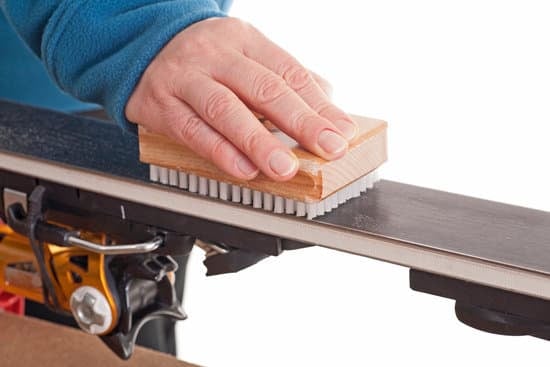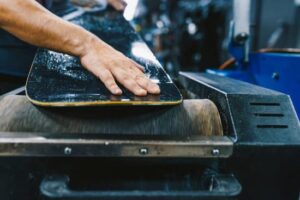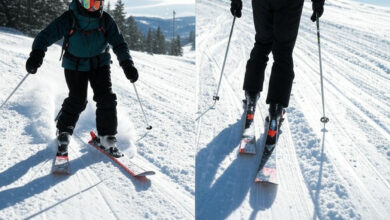How to Remove Ski Wax the Right Way for Better Performance

Remove Ski Wax is essential for keeping your skis in top condition. Waxing skis regularly improves their performance and longevity, but over time, repeated waxing can cause excess buildup. This buildup creates an uneven base layer, which may reduce glide efficiency. To maintain optimal performance, you need to remove old wax properly before applying a fresh coat.
“To maintain optimal ski performance, removing old or contaminated wax is crucial. Two effective methods exist for this purpose. The first utilizes a dedicated solvent designed to safely dissolve the wax buildup. The second is a “hot scrape” procedure: a layer of fresh wax is applied and quickly scraped away, thereby extracting dirt and impurities that have accumulated within the original wax layer.”
Removing wax from skis ensures that the base remains clean and smooth for better contact with the snow. When skis are waxed and scraped multiple times, the wax seeps into the tiny pores and contours of the base layer. While most skiers use wax to minimize friction, cross-country skiers rely on specialized wax that provides grip on inclines. Keeping the base clean from excess wax buildup allows for better control and glide, whether you’re skiing downhill or on flat terrain.
Contents
Waxing the base of your skis improves the following:
-
Enhanced Glide: Waxing creates a smoother ski base, significantly reducing friction and allowing for a faster, more effortless glide across the snow by follow the new ski approach.
-
Reduced Friction: The wax layer minimizes the contact surface between the ski base and the snow, thereby lessening friction and increasing speed.
-
Base Protection from Abrasions: Wax acts as a protective barrier, shielding the ski base from abrasive damage caused by ice crystals, stones, and other debris on the slopes.
-
Extended Base Lifespan: By reducing wear and tear, regular waxing contributes to a longer lifespan for the ski base, delaying the need for expensive repairs or replacements.
-
Water Repellency: Wax repels water, preventing meltwater from saturating the ski’s core, which can lead to warping, delamination, and reduced performance.
-
Core Integrity Preservation: The water-resistant properties of wax help maintain the structural integrity of the ski core by preventing moisture-related damage.
-
Optimized Performance in Varying Conditions: Different waxes can be selected to optimize performance in a wide range of snow conditions, from cold, dry powder to warm, wet slush.
-
Improved Static Friction (Cross-Country): For cross-country skiers, specialized “grip wax” or “kick wax” enhances static friction, enabling efficient uphill climbing without backsliding.
-
Enhanced Uphill Traction (Cross-Country): Grip wax provides the necessary traction for cross-country skiers to maintain control and power while ascending inclines.
-
Greater Control and Efficiency (Cross-Country): By preventing backsliding, grip wax allows cross-country skiers to maintain a consistent pace and conserve energy during uphill portions of their ski, resulting in greater control and efficiency.
Why Removing Wax From Skis is Necessary
When skis are waxed and scraped repeatedly, the result should be a super smooth base, as the wax penetrates the contours of the base layer. Most skiers employ wax to reduce friction between the ski and snow. This is particularly crucial for downhill skiing, where speed and control are paramount. However, over time, old wax becomes contaminated with dirt, debris, and oxidized material, slowing you down. Cross-country skiers use specialist wax, which grips on hills and needs to be removed when conditions change. Therefore, removing wax from skis is an important part of ski maintenance.

How to Remove Ski Wax?
Waxing skis is essential for optimal performance and extending their lifespan. The right wax minimizes friction, allowing for a smoother, faster glide. However, the repeated application of wax can lead to a buildup of residue and the creation of an uneven base layer over time. This accumulation can actually hinder performance, making it crucial to know how to remove ski wax effectively.
Methods for Ski Wax Removal
There are a few methods you can use to remove old ski wax. Here are some of the most common:
-
Scraping: This is the first line of defense against wax build-up. Use a plastic scraper (metal can damage the base) to remove as much excess wax as possible after each waxing session. Scrape in a single direction, from tip to tail. While scraping is essential, it won’t remove all the wax.
-
Hot Wax Scraping: This is a more thorough method. Apply a soft wax (a universal wax works well) and let it cool for a few minutes, but not harden completely. Then, scrape it off while it’s still warm and relatively soft. The fresh, warm wax will pull out some of the old, contaminated wax. Repeat this process a few times for best results.
This procedure starts offevolved with very well cleaning the ski base using mild cleaning soap and heat water to eliminate any surface contaminants. After allowing the bottom to dry absolutely, the ski undergoes a fashionable waxing cycle. Molten wax is cautiously carried out to the bottom through preserving a wax stick against a heated waxing iron, permitting the melted wax to drip onto the floor. The aim is to cowl the complete base with a uniform zigzag sample of molten wax.
Next, the waxing iron is lightly moved across the base in a continuous, sweeping motion from tip to tail. A thin, liquid film of wax must trail behind the iron, making sure even coverage throughout the complete floor. Crucially, rather than permitting the wax to fully harden, the base is right away scraped even as the wax continues to be heat and pliable. A plastic scraper is recommended for this step, as metal scrapers can doubtlessly harm the ski base if carried out with immoderate pressure. The warmth of the wax enables smooth removal, and, because it cools, it lifts the older, underlying wax layers, allowing them to be eliminated simultaneously.
Using each palms to firmly keep the scraper, it ought to be drawn alongside the entire duration of the ski, maintaining a horizontal orientation relative to the bottom surface. This ensures even and steady wax elimination. The corner of the scraper can then be cautiously used to smooth alongside the ski edges and the perimeter of the base, eliminating any residual wax buildup on the border.
The final degree of the recent wax scrape entails the usage of a brass or nylon brush to buff the ski base. This movement removes any closing traces of the authentic wax and prepares the surface for the following application of a new wax layer. Holding the comb across the width of the ski, practice mild stress and run it alongside the entire period from tail to tip, repeating this technique numerous instances. Optimal ski performance is frequently accomplished via multiple waxing cycles. Each additional cycle facilitates to clean out minor imperfections and irregularities in the base floor, growing a better drift. Consequently, following wax removal, it could require some waxing cycles to repair the bottom to its height overall performance level.
-
Using Ski Wax Remover: A dedicated ski wax remover is the most effective way to thoroughly clean your ski base. These solvents are specifically designed to dissolve and lift wax residue without damaging the base material.
-
Iron and Fiberlene Paper: This method uses heat and absorption. Lay Fiberlene paper (or a similar lint-free paper designed for ski base cleaning) over the base. Gently run a warm iron (set to a low temperature appropriate for waxing) over the paper. The heat will melt the wax, which will then be absorbed by the paper. Move the paper to a clean section frequently.
- Solvent Cleaners: While some skiers express reservations regarding the use of wax solvents, citing concerns about their potentially aggressive nature and the risk of stripping all wax from the base, they remain a popular choice when used according to the manufacturer’s instructions. Indeed, many skiers employ a combined approach, utilizing both hot wax removal techniques and solvents to achieve a thorough cleaning. It’s important to note that the ski base, composed of a durable, slightly porous polyethylene and graphite polymer, experiences minimal penetration from both wax and solvent cleaners during these processes.
Step-by-Step Guide to Using Ski Wax Remover
-
Ventilation: Work in a well-ventilated area. Ski wax removers can have strong fumes.
-
Preparation: Protect your work surface with newspaper or a drop cloth.
-
Application: Apply the ski wax remover liberally to the base of the ski. Follow the instructions on the specific product you’re using. Some are sprayed on, others are applied with a cloth.
-
Dwell Time: Allow the remover to sit for the recommended amount of time (usually a few minutes) so it can dissolve the wax.
-
Wiping: Wipe the base clean with a clean, lint-free cloth or Fiberlene paper.
-
Inspection: Inspect the base to ensure all the wax residue is gone. If necessary, repeat the process.

Tips for Success
-
Choose the Right Remover: Select a ski wax remover specifically designed for ski bases. Avoid using harsh solvents like paint thinner, as these can damage the base material.
-
Temperature Matters: Ideally, wax removal should be performed at room temperature.
-
Don’t Overheat: If using the iron and Fiberlene method, be careful not to overheat the base.
-
Regular Cleaning: Make wax removal part of your regular ski maintenance routine.
-
Base Brush: After cleaning, consider using a base brush to open up the pores of the base material and prepare it for new wax.
Note: Knowing how to remove ski wax is just as important as knowing how to apply it. By regularly removing old wax and keeping your ski bases clean, you’ll ensure optimal performance, extend the life of your skis, and enjoy a smoother, faster ride on the slopes. So, get cleaned and get ready to shred!
Step-by-Step Guide to Removing Ski Wax
Follow these simple steps to remove old ski wax effectively:
1. Gather the Necessary Tools
To properly remove ski wax, you’ll need:
- Ski wax remover (citrus-based or specialized ski base cleaner)
- Plastic or metal scraper
- Soft nylon brush or brass brush
- Microfiber cloth or lint-free towel
- Fibertex pad (optional for deep cleaning)
2. Scrape Off Excess Wax
Using a plastic scraper, gently remove the bulk of the wax from your skis. Hold the scraper at a 45-degree angle and apply even pressure while scraping from tip to tail. Avoid using excessive force to prevent damaging the base.
3. Apply Ski Wax Remover
Pour a small amount of ski wax remover onto a microfiber cloth and spread it evenly across the ski base. Let the remover sit for 2-3 minutes to break down any remaining wax residue.
4. Wipe and Brush the Base
Use a clean microfiber cloth to wipe off the loosened wax. Then, take a nylon or brass brush and scrub the base using long, even strokes. This helps remove any deeply embedded wax particles while restoring the ski’s natural structure.
5. Buff the Base with a Fibertex Pad
If there is still wax residue left, gently rub the base with a Fibertex pad. This step smooths out the surface and removes any stubborn wax buildup.
6. Let the Skis Dry
Allow your skis to air dry completely before applying a fresh coat of wax. This ensures that the ski base is clean and ready for optimal wax absorption.
7. Reapply Fresh Wax
Once your skis are dry and clean, apply a new layer of ski wax suitable for the snow conditions. This will restore glide and performance for your next skiing session.
Note: Regularly removing wax from skis is crucial for maintaining a smooth, high-performing base. By following these steps, you can ensure that your skis are always in top shape, ready to glide effortlessly on the slopes.

Tips for Effective Ski Wax Removal
✅ Use the Right Ski Wax Remover
- Choose a citrus-based or dedicated ski wax remover to break down excess wax without damaging the ski base. Avoid using household solvents, as they can degrade the ski material.
✅ Work in a Well-Ventilated Area
- Ski wax removers contain chemicals that can produce fumes. Always clean your skis in a well-ventilated space to avoid inhaling strong odors.
✅ Always Scrape in the Right Direction
- Scrape the wax from tip to tail in long, smooth strokes. This helps maintain the ski’s natural glide pattern and prevents uneven wear.
✅ Use a Brass or Nylon Brush for Better Results
- After applying the wax remover, brushing the ski base with a brass or nylon brush helps lift stubborn wax particles and restore the ski’s texture.
✅ Deep Clean Before Storing Skis
- At the end of the ski season, remove excess wax before storing your skis. This prevents wax buildup from hardening and keeps your skis in optimal condition for the next season.
✅ Test a Small Area First
- If you’re trying a new ski wax remover, test it on a small section of the ski base to ensure it doesn’t cause discoloration or damage.
Precautions to Avoid Ski Damage
❌ Don’t Use a Metal Scraper Aggressively
- Metal scrapers can damage the ski base if used incorrectly. Stick to plastic scrapers for routine wax removal, and use metal scrapers only if necessary.
❌ Avoid Excessive Pressure While Scraping
- Pressing too hard with a scraper can gouge or scratch the ski base. Use gentle, controlled strokes.
❌ Never Use Household Cleaners
- Common cleaners like alcohol, acetone, or detergents can dry out the ski base, reducing its ability to absorb fresh wax.
❌ Don’t Skip the Drying Process
- After removing wax, let your skis dry completely before applying new wax. Moisture trapped under wax can affect ski performance.
❌ Don’t Overuse Ski Wax Remover
- Using too much wax remover can strip away essential base material over time. Only use small amounts when necessary, and avoid frequent deep cleaning.

Conclusion:
Proper ski wax remover techniques and careful removing wax from skis will keep your skis in excellent shape, ready for smooth and efficient runs. Follow these tips and precautions to maintain your gear and get the best performance on the slopes!
Maintaining a clean ski base through effective wax removal is critical for maximizing performance and protecting your investment. The hot wax scrape and solvent methods each offer distinct advantages, and understanding both allows you to tailor your approach to your specific needs and preferences. By taking the time to remove old wax properly, you’ll unlock the full potential of your skis, ensuring a smoother, faster, and more enjoyable ride.




